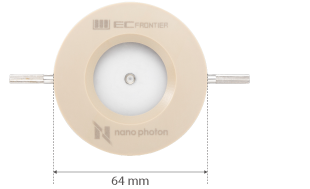
Dedicated charge/discharge cell for in-situ battery analysis
LIBcell charge is a cell for in-situ Raman analysis of the electrode surface. It measures the opposite electrode surface by passing laser through the holes of the counter electrode as well as the separator. Gas generated by charging and discharging will escape from the observation part located at the center of the cell and interference that affects the measurement is restrained
Specifications
| Size | Φ64 × 31 mm (Electrodes not included) |
| Weight | 600g |
| Material | PEEK / SUS316 |
| Window | Φ31 × t1mm quartz (t1.3mm at measurement area) |
| Size of electrodes (OD/ID) | 16mm/4mm (Observation) 16mm/4.5mm (Separator) 16mm/5mm (Counter) |
| Electrode for lead | SUS316 / 20mm |
| O-ring | Perflour / Buty |


Line illumination and laser scan perfect for in-situ measurement

Analysis by the use of LiBcell charge and Raman imaging visualizes the difference in how the progress status of charging reaction varies according to the locality. The result of in-situ Raman imaging of graphite anode is shown in the lower right image. Charging reaction is known to be in progress from the indication of high crystallinity due to the discharge status. Various charging and discharging process can be examined by in-situ with the change in electrode material and electrolyte solution, shift between anode and cathode along with the adoption of LIBcell charge.
Measure the electrode surface at the bottom by making small holes on the separator as well as the counter electrode and let laser pass through. The periphery of the opening which has a higher efficiency of charging and discharging reaction is targeted for analysis.

黒鉛負極のin-situラマンイメージング分析
| Excitation | 532 nm |
| Obj. lens | 50x, 0.70NA |
| Pixels | 8,000(400×20) |
| Measurement time | 14min / image |

X-line measurement mode is incorporated in laser Raman microscope RAMANtouch/RAMANforce which uses only one line of line illumination to measure. 400 spectra of the linear region from approximately 80μm to over several hundred μm (*1) can be obtained by one-shot exposure. Combine with the use of LIBcell charge, multi- point analysis is executable with charging and discharging being maintained after a short time interval
※1: The length of line illumination varies according to the magnification of objective.
※2: An example of a 50x objective lens being used.
※LIBcell charge developed jointly with EC Frontier., Inc.